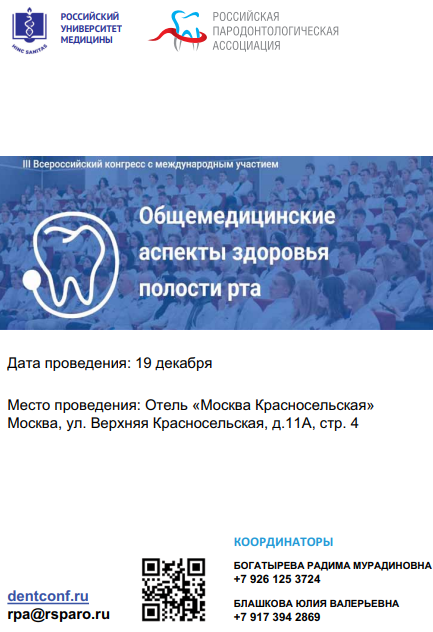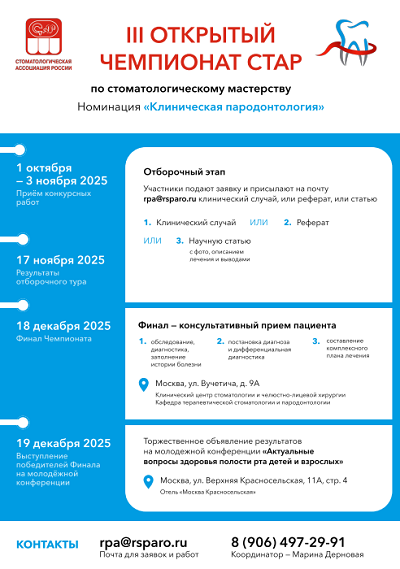Evaluation of the antiherpetic activity of toothpaste with herbal ingredients and rinses in the treatment of chronic generalized periodontitis
https://doi.org/10.33925/1683-3759-2020-25-2-141-147
Abstract
Relevance. There is very little literature data on the role of viral infection in the genesis of periodontal diseases, mainly the work of foreign authors. It is believed that the mucous membrane of the oral cavity, including the gums, is the habitat of some viruses of the herpes group (Epstein-Barr, cytomegalovirus, etc.). They can be in a latent state in the salivary glands, epithelial cells of the mucous membrane of the nasopharynx, oral cavity and under adverse conditions, are activated, causing an exacerbation of the process. Currently, methods for detecting viruses using laboratory tests (PCR diagnostics) have been somewhat simplified, which made it possible to evaluate the therapeutic effect of domestic oral care products against viruses. The use of plaque control agents such as prophylactic toothpastes and mouth rinses on a regular basis helps to reduce the risk of developing inflammatory periodontal diseases.
Purpose. To study the effect of domestic oral care products on the level of oral cavity contamination with herpes group viruses in patients suffering from chronic generalized periodontitis.
Materials and methods. Under clinical supervision were 52 patients (28 men, 24 women) of middle age 31-54 years with chronic generalized periodontitis of moderate severity, divided into groups: group 1 – 26 patients who used «Asepta Sensitive» preventive toothpaste on basis of plant components. They were divided into 2 subgroups of 13 patients: subgroup «a»- only paste, subgroup «b» - paste with the additional use of rinse aid «Asepta ® Active» in the first 8 days with a further transition to rinse «Asepta ® Fresh» from 9 days of the study. Group 2 consisted of 26 patients who used «Asepta ® Active» toothpaste with a similar division into subgroups: subgroup «a» without rinsing agents and subgroup «b» with rinsing agents. The control group of patients without inflammatory diseases of the periodontium and oral mucosa included 15 people who were not treated.
Results. It was revealed that the DNA of the herpes simplex virus ½ types (HSV ½) at the beginning of the study was detected in 28.8% of patients with periodontitis, Epstein-Barr virus 42.3% of patients, and cytomegalovirus in 36.5%. When using oral care products containing antiseptics, adult patients suffering from chronic generalized periodontitis, we have achieved good results in the treatment of this disease. The effectiveness of the action of toothpaste and rinses in adults with chronic generalized periodontitis is high – a decrease in performance by an average of 1.2-2 times lower than without rinse aid. This allows, subject to the rules of individual oral hygiene, to quickly stop the main clinical symptoms of chronic generalized periodontitis and reduce the level of oral contamination by herpes viruses.
Conclusion. In the treatment of patients with chronic generalized periodontitis, no significant clinical differences were found when using various schemes for the use of oral care products. At the same time, the use of the «Asepta ® Active» rinse agent with chlorhexidine helps to reduce the frequency of detection of herpes group viruses in the oral cavity by 1.5-2.5 times and reduces the signs of periodontal inflammation in patients with chronic generalized periodontitis.
About the Authors
M. E. MalyshevRussian Federation
Malyshev Mihail E., DSc, Professor of the Department of Maxillofacial Surgery and Surgical Dentistry, St. Petersburg State University, Head of the City Laboratory of Immunogenetics and Serodiagnosis State budgetary healthcare institution «St. Petersburg Scientific Research Institute of Emergency Care named after I.I. Dzhanelidze
Saint Petersburg
A. A. Petrov
Russian Federation
Petrov Anton A., Assistant lecturer of the Department of Clinical Dentistry, Private educational institution of higher professional education «St. Petersburg Medical and Social Institute», dentist-surgeon-periodontist State budgetary healthcare institution " Dental clinic No. 29»
Saint Petersburg
A. K. Iordanishvili
Russian Federation
Iordanishvili Andrey K., DSc, Professor, Chief Scientific Secretary of the International Academy of Ecology, Safety of Man and Nature, Professor of the Department of Maxillofacial Surgery and Surgical Dentistry
Saint Petersburg
References
1. M. Kebschull, P. N. Papapanou. Periodontal microbial complexes associated with specific cell and tissue responses. Journal of Clinical Periodontology. 2011;38(11):17-27. https://doi.org/10.1111/j.1600-051X.2010.01668.x.
2. A. V. Colombo, C. M. Silva, A. Haffajee. Identification of oral bacteria associated with cervicular epithelial cells from chronic periodontitis lesions. Journal of Medical Microbiology. 2006;55:609-615. https://doi.org/10.1099/jmm.0.46417-0.
3. B. Riep, L. Edesi-Neuss, F. Claessen, H. Skarabis, B. Ehmke, T. F. Flemmig, J. P. Bernimoulin, U. B. Göbel, A. Moter. Are putative periodontal pathogens reliable diagnostic markers? Journal of Medical Microbiology 2009;47(6):1705-1711. https://doi.org/10.1128/JCM.01387-08.
4. L. Abusleme, A. K. Dupuy, N. Dutzan, N. Silva, J. A. Burleson, L. D. Strausbaugh, J. Gamonal, P. I. Diaz. The subgingival microbiome in health and periodontitis and its relationship with community biomass and inflammation. ISME Journal. 2013;7(5):1016-1025. https://doi.org/10.1038/ismej.2012.174.
5. I. Saygun, A. Kubar, S. Sahin, K. Sener, J. Slots. Quantitative analysis of association between herpesviruses and bacterial pathogens in periodontitis. Journal of Periodontal Research. 2008;43:352-359. https://doi.org/10.1111/j.1600-0765.2007.01043.x.
6. M. Chalabi, F. Rezaie, S. Moghim, A. Mogharehabed, M. Resave, B. Mehraban. Periodontopathic bacteria and herpesviruses in chronic periodontitis. Molecular oral microbiology. 2010;25(3):236-240. https://doi.org/10.1111/j.2041-1014.2010.00571.x.
7. A. Kato, K. Imai, K. Ochiai, Y. Ogata. Higher prevalence of Epstein-Barr virus DNA in deeper periodontal pockets of chronic periodontitis in Japanese patients. PLOS One. 2013;8(8):71990. https://doi.org/10.1371/journal.pone.0071990.
8. L. Nibali, C. Atkinson, P. Griffiths, U. Darbar, T. Rakmanee, J. Suvan. Low prevalence of subgingival viruses in periodontitis patients. Journal of Clinical Periodontology. 2009;36: 928-932. https://doi.org/10.1111/j.1600-051X.2009.01476.x.
9. R. Sharma, O. Padmalatha, G. Kaarthikeyan, N. D. Jayakumar, S. Varghese, K. Sherif. Comparative analysis of presence of Cytomegalovirus (CMV) and Epsteinbarr virus-1 (EBV-1) in cases of chronic periodontitis and aggressive periodontitis with controls. Indian Journal of Dental Research 2009;23:454-458. https://doi.org/10.4103/0970-9290.104948.
10. W. Teughels, I. Sliepen, M. Quirynen, S. K. Haake, J. Van Eldere, P. Fives-Taylor et al. Human cytomegalovirus enhances A. actinomycetemcomitans adherence to cells. Journal of Dental Research. 2007;86:175-180. https://doi.org/10.1177/154405910708600213.
11. A. R. Naqvi, J. Shango, A. Seal, D. Shukla, S. Nares. Herpesviruses and MicroRNAs: New Pathogenesis Factors in Oral Infection and Disease. Frontiers in Immunology. 2018;27(9):2099. https://doi.org/10.3389/fimmu.2018.02099.
12. A. I. Shatokhin, E. V. Volchkov. Role of herpes viruses in periodontal disease pathogenesis. Stomatology. 2016;95(2):89-91. (In Russ.). https://doi.org/10.17116/stomat201695289-91.
13. J. E. Botero, B. Parra, A. Jaramillo, A. Contreras. Subgingival human cytomegalovirus correlates with increased clinical periodontal parameters and bacterial coinfection in periodontitis. Journal of Periodontology. 2007;78:2303. https://doi.org/10.1902/jop.2007.070252.
14. J. Slots, H. Slots. Bacterial and viral pathogens in saliva: Disease relationship and infectious risk. Periodontology. 2011;55(1):48-69. https://doi.org/10.1111/j.1600-0757.2010.00361.x.
15. J. Slots. Herpesvirus periodontitis: infection beyond biofilm. Journal of the American Dental Association. 2011;39(6):393-399. ttps://www.ncbi.nlm.nih.gov/pubmed/21823497.
16. Indices and criteria for assessing the dental status of the population / red. prof. A.M. Hamadeeva. Samara: OOO «Ofort». 2017:218. (In Russ.).
17. B. R. Glick, J. J. Pasternak. Molecular Biotechnology. Plinciples and Applications of Recombinant DNA. Moscow: «Mir». 2002:589. (In Russ.).
18. M. M. Kazi, R. Bharadwaj, K. Bhat, D. Happy. Association of Herpes Viruses with Mild, Moderate and Severe Chronic Periodontitis. Journal of Clinical and Diagnostic Research. 2015;9(7):5-8. https://doi.org/10.7860/JCDR/2015/13781.6187.
19. S. A. Nishiyama, V. Nakano, G. Velásquez-Melendez, M. J. Avila-Campos. Occurrence of herpes simplex virus 1 and three periodontal bacteria in patients with chronic periodontitis and necrotic pulp. Canadian Journal of Microbiology. 2008;54(4):326-330. https://doi.org/10.1139/w08-006.
20. L. J. Ling, C. C. Ho, C. Y. Wu, Y. T. Chen, S. L. Hung. Association between human herpesviruses and the severity of periodontitis. Journal of Periodontology. 2004;75:1479-1485. https://doi.org/10.1902/jop.2004.75.11.1479.
21. A. Contreras, H. Nowzari, J. Slots. Herpesviruses in periodontal pocket and gingival tissue specimens. Oral Microbiology and Immunology. 2000;15(3):15-18. https://doi.org/10.1034/j.1399-302x.2000.150103.x.
22. G. Grenier, G. Gagnon, D. Grenier. Detection of herpetic viruses in gingival crevicular fluid of patients suffering from periodontal diseases: prevalence and effect of treatment. Oral Microbiology and Immunology. 2009;24(6):506-509. https://doi.org/10.1111/j.1399-302X.2009.00542.x.
23. P. T. Sunde, I. Olsen, M. Enersen, B. Grinde. Patient with severe periodontitis and subgingival Epstein-Barr virus treated with antiviral therapy Journal of Clinical Virology 2008;42(2):176-178. https://doi.org/10.1016/j.jcv.2008.01.007.
24. R. Teanpaisan, P. Kawsud, N. Pahumunto, J. Puripattanavong. Screening for antibacterial and antibiofilm activity in thai medicinal plant extracts against oral microorganisms. Journal of Traditional Complementary Medicine. 2017;7:172-177. https://doi.org/10.1016/j.jtcme.2016.06.007.
25. B. Salehi, P. Lopez-Jornet, E. Pons-Fuster López, D. Calina, M. SharifiRad, K. Ramírez-Alarcón, K. Forman, M. Fernández, M. Martorell, W. N. Setzer, N. Martins, C. F. Rodrigues, J. Sharifi-Rad. Plant-Derived Bioactives in Oral Mucosal Lesions: A Key Emphasis to Curcumin, Lycopene, Chamomile, Aloe vera, Green Tea and Coffee Properties. Biomolecules. 2019;17:9(3):106. https://doi.org/10.3390/biom9030106.
26. Khromova E.A., Kulik I.V., Udaltsova N.A., Iordanishvili A.K. Peculiarity of local treatment-preventive activities in the treatment of parodontitis in patients with diabetes type 2. Parodontologiya. 2018;24(4):67-70. (In Russ.) https://doi.org/10.25636/PMP.1.2018.4.12.
27. F. Ripari, A. Cera, M. Freda, G. Zumbo, F. Zara, I. Vozza. Tea Tree Oil versus Chlorhexidine Mouthwash in Treatment of Gingivitis: A Pilot Randomized, Double Blinded Clinical Trial. European Journal of Dentistry. 2020;14(1):55-62. https://doi.org/10.1055/s-0040-1703999.
28. L. Fiorillo. Chlorhexidine Gel Use in the Oral District: A Systematic Review. Gels. 2019;11:5(2):31. https://doi.org/10.3390/gels5020031.
29. Abdurakhmanova S.A., Runova G.S., Podporin M.S., Tsareva E.V., Ippolitov E.V., Tsarev V.N. Microbiological substantiation of application of phytopreparations in treatment of inflammatory periodontal diseases. Parodontologiya. 2019;24(3):196-202. (In Russ.) https://doi.org/10.33925/1683-3759-2019-24-3-196-202.
Review
For citations:
Malyshev ME, Petrov AA, Iordanishvili AK. Evaluation of the antiherpetic activity of toothpaste with herbal ingredients and rinses in the treatment of chronic generalized periodontitis. Parodontologiya. 2020;25(2):141-147. (In Russ.) https://doi.org/10.33925/1683-3759-2020-25-2-141-147




































